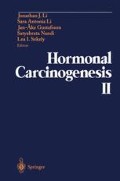Abstract
The estrogen receptor belongs to a large family of nuclear receptors whose activity as a transcription factor depends on the binding of a hormonal ligand (1). As with other steroid receptors, in the absence of ligand the estrogen receptor is found in an oligomeric complex that is unable to bind to DNA (2–4). Following hormone binding, the complex is dissociated to allow receptor dimerization, high-affinity DNA binding, and transcriptional activation (5, 6). In the estrogen receptor, there are at least two regions called activation functions, or AFs, which are required to stimulate transcription (7, 8). The relative activities of AF-1, located in the N-terminal domain, and AF-2, in the C-terminal hormone binding domain, vary according to the responsive promoter and target cells.
Access this chapter
Tax calculation will be finalised at checkout
Purchases are for personal use only
Preview
Unable to display preview. Download preview PDF.
References
Parker MG (1993) Steroid and related receptors. Curr Opinion in Cell Biol 5:499–504.
Catelli MG, Binart N, Jung TI, et al. (1985) The common 90-kd protein component of non-transformed ‘8S’ steroid receptors is a heat-shock protein. EMBO J 4:3131–3135.
Chambraud B, Berry M, Redeuilh G, et al. (1990) Several regions of the human estrogen receptor are involved in the formation of receptor-heat shock protein 90 complexes. J Biol Chem 265:20686–20691.
Schlatter LK, Howard JK, Parker MG, Distelhorst CW (1992) Comparison of the 90-kilodalton heat shock protein interaction with in vitro translated glucocorticoid and estrogen receptors. Mol Endocrinol 6:132–140.
Kumar V, Chambon P (1988) The estrogen receptor binds tightly to its responsive element as a ligand-induced homodimer. Cell 55:145–156.
Fawell SE, Lees JA, White R, Parker MG (1990) Characterization and colocalization of steroid binding and dimerization activities in the mouse estrogen receptor. Cell 60:953–962.
Tora L, White J, Brou C, et al. (1989) The human estrogen receptor has two independent nonacidic transcriptional activation functions. Cell 59:477–487.
Lees JA, Fawell SE, Parker MG (1989) Identification of two transactivation domains in the mouse oestrogen receptor. Nucleic Acids Res 17:5477–5488.
Jordan VC, Murphy CS (1990) Endocrine pharmacology of antiestrogens as antitumor agents. Endocrine Rev 11:578–610.
Jordan VC (1984) Biochemical pharmacology of antiestrogen action. Pharmacol Rev 36:245–76.
Berry M, Metzger D, Chambon P (1990) Role of the two activating domains of the oestrogen receptor in the cell-type and promoter-context dependent agonistic activity of the anti-oestrogen 4-hydroxytamoxifen. EMBO J 9:2811–2818.
Bowler J, Lilley TJ, Pittam JD, Wakeling AE (1989) Novel steroidal pure antiestrogens. Steroids 54:71–99.
Wakeling AE, Dukes M, Bowler J (1991) A potent specific pure antiestrogen with clinical potential. Cancer Res 51:3867–3873.
Dauvois S, Danielian PS, White R, Parker MG (1992) Antiestrogen ICI 164,384 reduces cellular estrogen receptor content by increasing its turnover. Proc Natl Acad Sci USA 89:4037–4041.
Gibson MK, Nemmers LA, Beckman Jr WC, et al. (1991) The mechanism of ICI 164,384 antiestrogenicity involves rapid loss of estrogen receptor in uterine tissue. Endocrinology 129:2000–2010.
Reese JC, Katzenellenbogen BS (1992) Examination of the DNA-binding ability of estrogen receptor in whole cells: Implications for hormone-dependent transactivation and the actions of antiestrogens. Mol Cell Biol 12:4531–4538.
King WJ, Greene GL (1984) Monoclonal antibodies localize oestrogen receptor in the nuclei of target cells. Nature 307:745–747.
Welshons WV, Krummel BM, Gorski J (1985) Nuclear localization of unoccupied receptors for glucocorticoids, estrogens, and progesterone in GH3 cells. Endocrinology 117:2140–2147.
Kalderon D, Richardson WD, Markham AT, Smith AE (1984) Sequence requirements for nuclear location of simian virus 40 large-T antigen. Nature 311:33–38.
Kalderon D, Roberts BL, Richardson WD, Smith AE (1984) A short amino acid sequence able to specify nuclear location. Cell 39:499–509.
Lanford RE, Butel JS (1984) Construction and characterization of an SV40 mutant defective in nuclear transport of T antigen. Cell 37:801–813.
Dingwall C, Laskey RA (1991) Nuclear targeting sequences: A consensus? TIBS 16:478–481.
Ylikomi T, Bocquel MT, Berry M, et al. (1992) Cooperation of proto-signals for nuclear accumulation of estrogen and progesterone receptors. EMBO J 11:1–14.
Guiochon-Mantel A, Loosfelt H, Lescop P, et al. (1989) Mechanisms of nuclear localization of the progesterone receptor: evidence for interaction between monomers. Cell 57:1147–1154.
Guiochon-Mantel A, Lescop P, Christin-Maitre S, et al. (1991) Nucleo-cytoplasmic shuttling of the progesterone receptor. EMBO J 10:3851–3859.
Chandran UR, De Franco DB (1992) Internuclear migration of chicken progesterone receptor, but not simian virus-40 large tumor antigen, in transient heterokaryons. Mol Endocrinol 6:837–844.
De Franco DB, Qi M, Borror KC, et al. (1991) Protein phosphatase types 1 and/or 2A regulate nucleocytoplasmic shuttling of glucocorticoid receptors. Mol Endocrinol 5:1215–1228.
Dauvois S, White R, Parker MG (1993) The antiestrogen ICI 182780 disrupts estrogen receptor nucleocytoplasmic shuttling. J Cell Sci 106:1377–1388.
Henry JA, McCarthy AL, Angus B, et al. (1990) Prognostic significance of the estrogen-regulated protein, cathepsin D, in breast cancer. Cancer 65:265–271.
Editor information
Editors and Affiliations
Rights and permissions
Copyright information
© 1996 Springer-Verlag New York, Inc.
About this paper
Cite this paper
Dauvois, S., Parker, M.G. (1996). Nucleocytoplasmic Shuttling of Estrogen Receptors is Blocked by “Pure Anti-Estrogens”. In: Li, J.J., Li, S.A., Gustafsson, JÅ., Nandi, S., Sekely, L.I. (eds) Hormonal Carcinogenesis II. Springer, New York, NY. https://doi.org/10.1007/978-1-4612-2332-0_8
Download citation
DOI: https://doi.org/10.1007/978-1-4612-2332-0_8
Publisher Name: Springer, New York, NY
Print ISBN: 978-1-4612-7506-0
Online ISBN: 978-1-4612-2332-0
eBook Packages: Springer Book Archive

